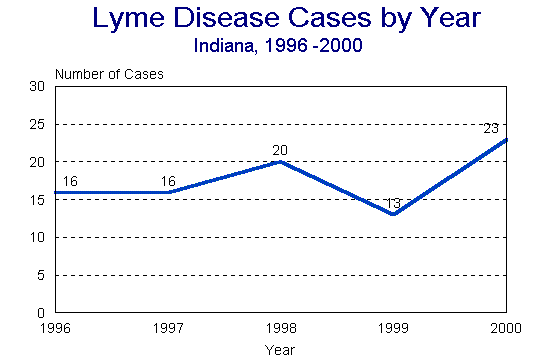Figure Lym1: Lyme Disease Cases by Year, Indiana, 1996 - 2000

2000 Indiana Report of Infectious Diseases |
View ISDH's Quick Facts on Lyme Disease
View CDC's Lyme Disease page
Rates presented are per 100,000 population and are based on the U.S. 2000 Census.
Cases = 23
In 2000, 23 reported cases of Lyme disease met the CDC definition as a confirmed case in Indiana. Cases were reported in 15 females and 8 males. The ages ranged from 3 to 68 years, with a mean age of 33.3 years.
From 1996-2000, the number of reported cases of Lyme disease in Indiana has varied from a low of 13 cases to a high of 23 with the average number of reported cases being 17.6. Figure Lym1 shows the number of reported cases in Indiana by year from 1996 to 2000. The number of cases by age group is presented in Figure Lym2. Figure Lym3 illustrates the five-year incidence rate for the same age groups. Individuals between the ages of 30-59 years appear to be at an increased risk for acquiring infection. These differences may be due to varying occupational or recreational exposures among the various age groups. From 1996-2000, cases were reported in 44 females and 55 males for a female to male ratio of 1:1.14. On the basis of sex alone there is little difference in risk for infection. Only 70 of the 94 cases that were reported from 1996-2000 identified the race of the victim: 69 were white, and 1 was black.
Lyme disease is maintained in nature in a cycle involving mice; deer; and the tick; Ixodes scapularis, that transmits the disease while obtaining a blood meal. Surveys for the tick in Indiana have identified the vector most frequently in the northwestern counties of Indiana. Each year, the tick's presence is identified in additional counties and is potentially present in all counties. I. scapularis ticks were identified in six additional counties in 2000, bringing the total number of Indiana counties with at least one tick identified to 53. Figure Lym4. illustrates the number of reported cases of Lyme disease by county of residence from 1991-2000.
A report prepared by Dr. Robert Pinger of Ball State University describing in more detail the distribution of ticks that are vectors for Lyme disease can be found on the Ball State University web site at: http://web.bsu.edu/physiology/new_website/ento_lab_phel.asp.
Back to Top of Article
Back to Table of Contents
|
Figure Lym1: Lyme Disease Cases by Year, Indiana, 1996 - 2000 |
|
|
Back to Reference in Text
Back to Top of Article
|
Figure Lym2: Lyme Disease Incidence by Age Groups, Indiana, 1996-2001 |
|
|
Back to Reference in Text
Back to Top of Article
|
Figure Lym3: Five-Year Incidence Rates, Lyme Disease by Age Group, Indiana, 1996 - 2000 |
|
|
Back to Reference in Text
Back to Top of Article
|
Figure Lym4: Confirmed Human Lyme Cases by County of Residence, Indiana, 1991-2000 |
|
|
Back to Reference in Text
Back to Top of Article
Back to Table of Contents
[an error occurred while processing this directive]